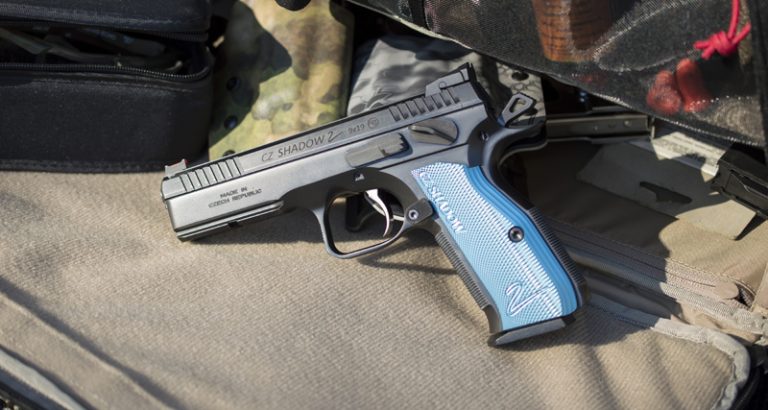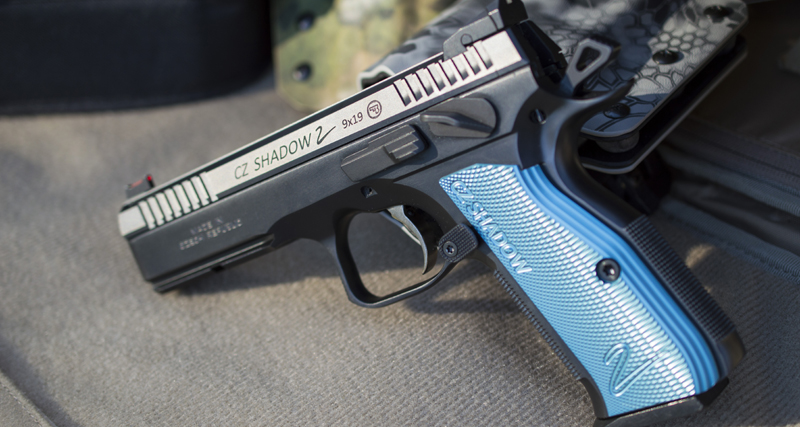
At Calibre, sometimes we get a gun sent to us which generates more interest than we expect. Other times, less interest. Usually this is a function of when the release date is, and how new or innovative the idea is, and whether the gun is non-restricted. Non-restricted guns that have just been announced, with a really interesting feature set, generally arouse the magazine-reading public. Restricted guns that are an incremental improvement on past guns, which have been known about for months, usually have a more subdued impact. And usually we’re pretty good at predicting this effect.
When we took the CZ Shadow 2 to the range for the first time, a casual social media post turned into an on-the-spot mobbing as the post was shared (by notable CZ shooter Rob Engh, which no doubt had an effect) in real time, and then we hardly got to shoot it for the rest of the evening, because everyone wanted to pose with it for pictures.
We thought we were pretty good at predicting buzz, but man, we really did not see that coming.
Česká zbrojovka Uherský Brod, far more popularly known as CZ for reasons we can’t explain, launched the Shadow 2 at the German arms expo IWA in March of this year as the company’s IPSC (that’s International Practical Shooting Confederation, and one of Canada’s most popular handgun sports) Production class gun, the second generation of the extremely successful CZ SP-01 Shadow. The original Shadow was a refined CZ-75, which itself is a traditional double action steel 9mm service pistol originally built in 1975 and popular among military and police organizations worldwide, although it never really took off in the West, where it faced stiff competition from the 1911 in the US, and the Browning Hi-Power everywhere else. Conditioned as we were to single action triggers, the long first pull of the CZ-75, particularly when coupled with the somewhat questionable commitment to manufacturing excellence down at the old Uherský Brod of 1975, not to mention a good old-fashioned red scare, relegated it to use primarily among eastern bloc countries and third world armies.

Regardless, the original SP-01 Shadow was the best deal going in a competition pistol, no question about it. But it was getting a little long in the tooth, and while it remained very competitive in IPSC, the list of features was starting to look a little bit threadbare, and the upmarket editions like the Shadow Mate and so on started looking less like high-dollar options for big money gamers, and more like necessary upgrades.
And so we come to the next generation of the Shadow, the Shadow 2. We’ll just go ahead and get this over with: the Shadow 2 is an excellent pistol and if you’re on the fence about whether it’s worth it to get one, get off the fence. This is a superb gun and there isn’t another pistol in its price range that can touch it. If you want one, get one. You won’t be disappointed.
We’re going to try to avoid drilling down into every technical difference between the Shadow and the Shadow 2 and just treat this as a new pistol for the sake of shooters who aren’t owners of the original, but some comparisons are worth making, in particular with regards to the frame and the trigger.
The frame is two millimetres wider than the original, with a much deeper relief under the beavertail to compensate. The effect is a rounder grip, but it gives up nothing in terms of comfort or even trigger reach to the original. In fact, the noticeable thing about the grip for most of us wasn’t the dimensions, it was the checkering, which is so superior to the original Shadow’s few lines of cast checkering on the front strap that it’s not even a comparison, it’s a revelation. The Shadow 2 is checkered like a quality 1911 is checkered, with sharp, machined lines. The original was usually found at matches with grip tape covering the checkering, which gives some idea of its utility.
The ergonomics of the new frame also include a completely redesigned trigger guard, which now contains a enormous and rather rectangular space, barricaded with a vertical front bar. The frame itself is relieved a bit above the trigger making this the most generously accommodating trigger guard we can think of short of full-custom race guns. If you can’t get your trigger finger on this go-button in a hurry, you’ll have to look elsewhere for the explanation.

One noticeable change which we found both visually apparent and which affected our manipulation of the firearm itself is the new slide. It’s sleek, but it’s also difficult to grab. IPSC shooters likely won’t find this to be a huge detriment, slide lock reloads being somewhat less appealing to employ with regularity when hundredths of a second count, but it’s one of our two quibbles with the gun. We like a meatier slide, and while this slide may well suit the purposes of committed gamers, for us it’s a little awkward.

On the plus side, if one of your two complaints is “I hate this font” then you know the pistol is very, very good.
So when you get this excited about a pistol just pulling it out of the box, what’s next? You go shoot it, of course. And as it turns out, you draw a crowd and end up letting everyone else shoot it, too.


The mag release is also improved from the original; an interchangeable pad that can be tuned to suit your preferences with a torx wrench.

The remaining changes won’t affect Canadians much, for both good and ill. It’s an Australia-legal barrel length, something we’re happy to report doesn’t mean anything here. Sadly, we can’t benefit from the fact that the magazine capacity in freer jurisdictions has been upped to 19. Sorry, Canadians. You can absolutely buy guns, but a magazine designed to hold eleven or more rounds and not displaying a pop rivet to keep the world from ending? Obviously that is a bridge too far.
